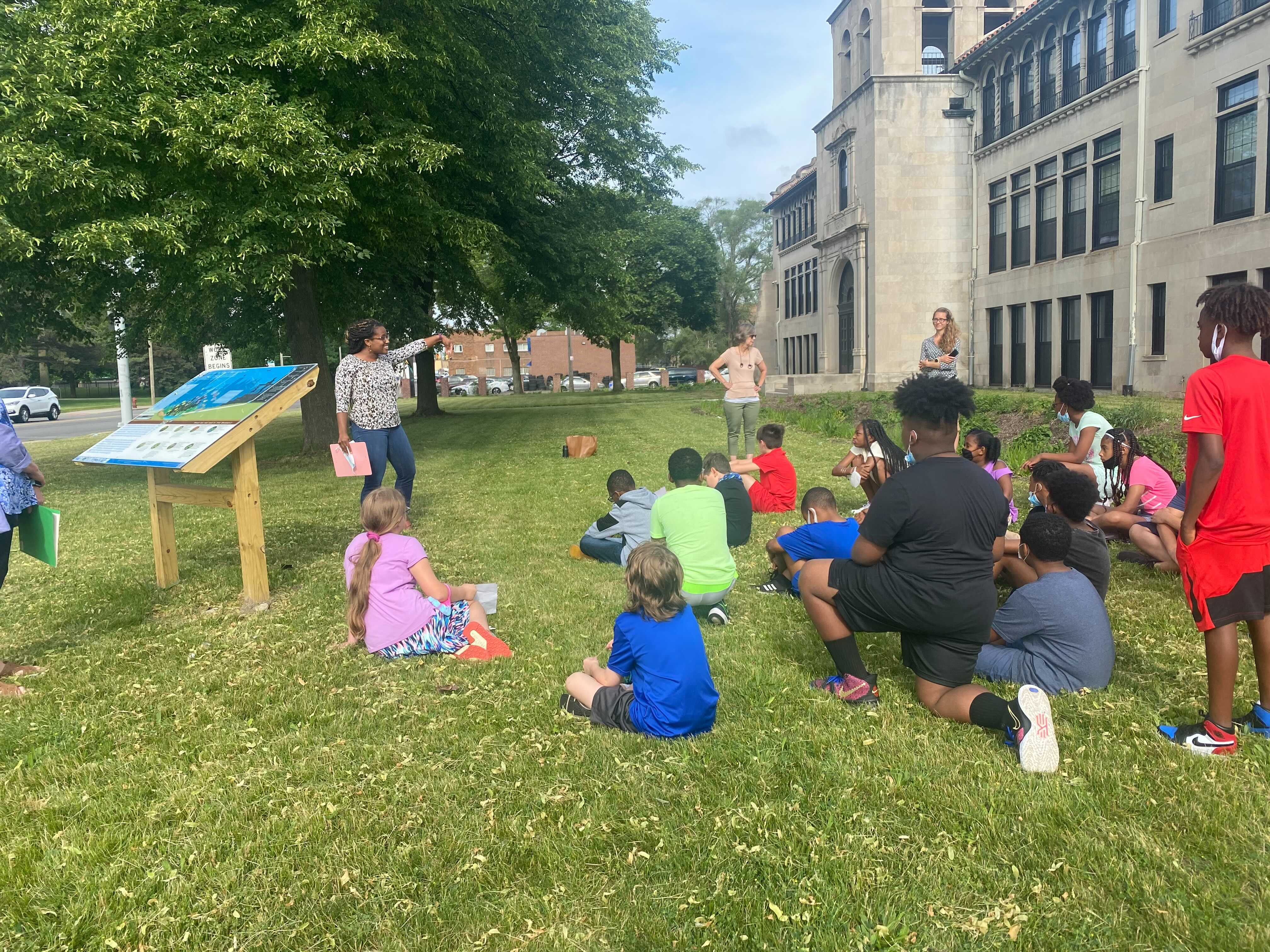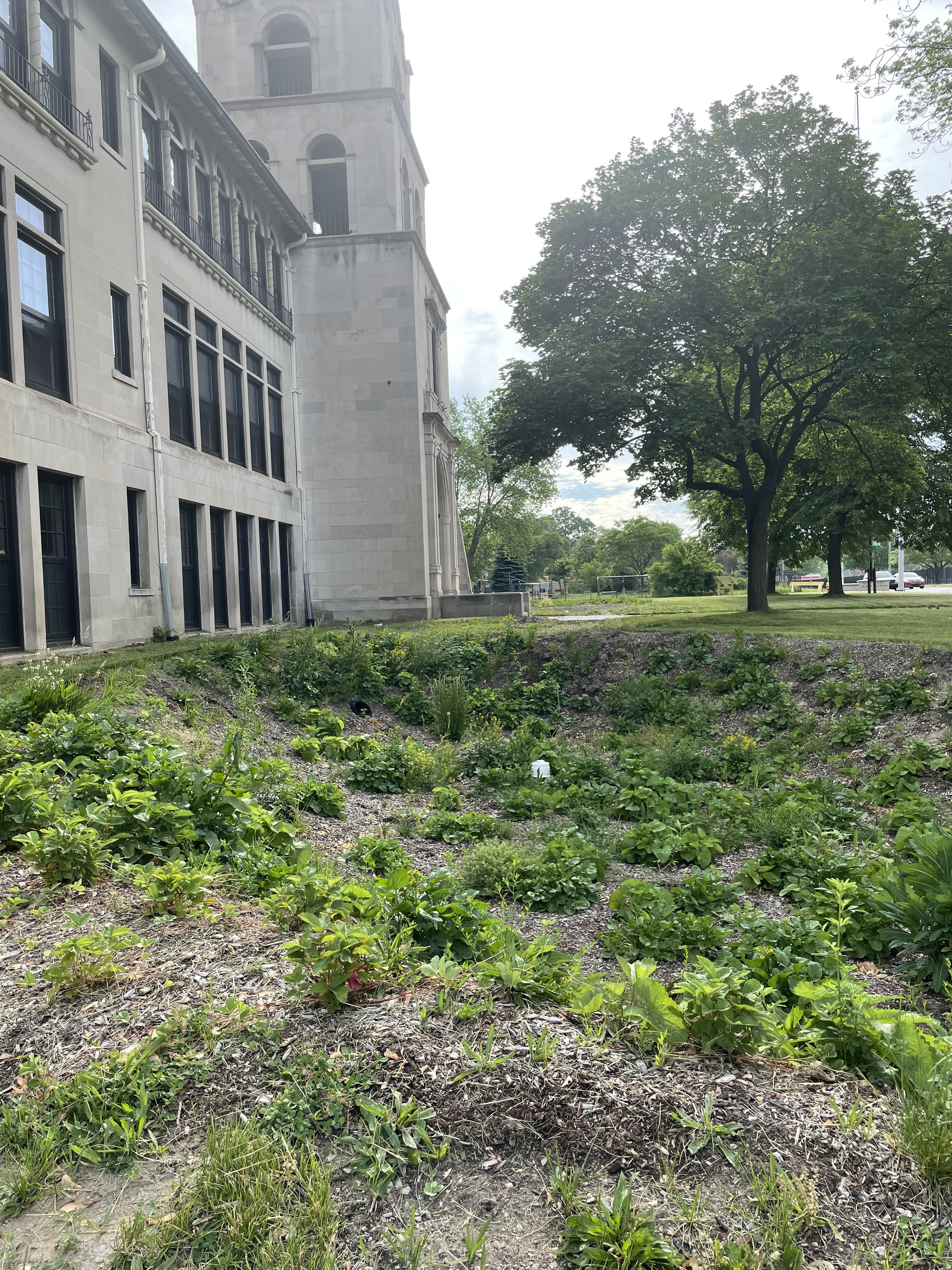Outside the massive limestone facade of Gesu Catholic Church and School in Detroit, Michigan, a group of fifth- and sixth-graders sit on the grass next to two rain gardens filled with native plants—perennial flowers and grasses like Black Eyed Susans, Wild Strawberry, and Indian grass.
The gardens are a new addition to the grounds of the 85-year-old church, recently established by students, parishioners and community members. In addition to serving as critical wildlife and pollinator habitat, the beds are built to capture rain from the church's roof and asphalt surfaces, allowing it to slowly seep into the garden soil rather than enter Detroit's bulging sewers. the storms.
“Both of these gardens together are big enough to absorb the rainwater from a 100-year storm,” explained Liam Nantais, one of the fifth-graders who helped build the green spaces. The gardens, along with two new dry wells and five 500-gallon rain barrels on Gesu's six-acre campus, are capable holding up to nearly 3,000 cubic feet of rainwater.
The gardens at Gesu Catholic Church are part of a growing network of “Sacred Places” sites, a collaborative initiative between houses of worship and the National Wildlife Federation, or NWF, to build native plants and educate churches and communities about care for the environment. . First launched on the East Coast a decade ago, the program's gardens and educational programs are now popping up at religious sites across the country, including places where phrases like “climate change” remain taboo.
The program has become increasingly popular in the Midwest in recent years. Four years ago, a coalition of Toledo, Ohio groups approached NWF about expanding the Sacred Grounds network to their city. Now, over 20 houses of worship throughout Toledo participate in the program, and there are a growing number of gardens in Grand Rapids and Detroit. By the end of the year, NWF plans to have 80 Sacred Grounds locations across the country.
“There's an opportunity for people to have more open and healing conversations around nature and natural spaces by providing that common ground, literally,” said Manja Holland, national director of the Sacred Grounds program for the National Wildlife Federation.
Faith communities are often under-engaged and underutilized members of the environmental movement. “The issue is on the conservation side,” said Martin Palmer, general secretary of the Faith and Conservation Alliance. Ensia said. “They need to really invite the faith side to the table and stop pretending that no one other than environmental organizations has done work in this area.”

Jena Brooker/Grist
This exclusion comes despite the enormous fundamental values of environmental stewardship embedded in the teachings of many religions and widespread concern among colleagues. In the Bible, for example, there are around 100 verses who talk about protecting the environment. There are hundreds in the Quran, and the 32nd greatest sin in Islam is wasteful consumption. In Buddhism, karma, interdependence, and the vow to protect all life are related to the environment. According to a 2014 study Conducted by the Public Religion Research Institute, more American Hispanic Catholics are classified as “very concerned” about climate change than those unaffiliated with a religion — 43 percent to 38 percent, respectively. Additionally, one-third of the foundations that have committed to divest from fossil fuels worldwide are faith-based organizations, according 350.org, a non-profit organization working to end fossil fuel use and build community renewable energy.
“At least 85 percent of the world's people are part of religions and we cannot leave them out [the environmental movement]Mary Evelyn Tucker, a scholar of religion and the environment at Yale University, told Grist.
But the lack of environmental engagement with—and within—religious groups is changing, even in communities where conversations around the environment have traditionally been difficult.
The Meditation Missionary Baptist Church on Detroit's west side there is a predominantly black community of about 70 members. The church is part of the Southern Baptist Convention – a denomination whose view on climate change over the past four decades has shifted from say the experts he was sympathetic to environmentalism to the point of being “indistinguishable from that of secular conservatives in the climate denial movement.”
Glenn Hodges, assistant pastor at Meditation Missionary, said climate change and the environment are not topics that are generally discussed with the church because of other pressing priorities, such as equality and inclusion, safe housing and tackling crime. “The struggles we face are different in the community we're in.”
But in 2019, the church chose to build a rain garden as part of its Sacred Grounds program because community members wanted to create an enjoyable green space—and the rain garden would serve the dual purpose of managing excess stormwater.
Flooding is a huge issue in Detroit. Just last weekend, Michigan Governor Gretchen Whitmer declared a state of emergency after Wayne County, where Detroit is located, received more than 6 inches of rain in 12 hours, forcing hundreds of drivers to abandon their cars on flooded highways, damaging homes and businesses and causing power outages.
Part of the problem is that Detroit, like many cities, is covered in impervious surfaces — parking lots, sidewalks and roofs that don't allow rainwater to soak into the ground. And the city is getting old combined sewer system easily overflows, leading water to flow into the Rouge or Detroit Rivers and flood neighborhoods in the process. A template for one new study shows that nearly 40 percent of Detroit residents surveyed have experienced flooding as a result of rainfall.
To make matters worse, Detroit's water bills are determined in part by the amount of impervious surface on a property – leading to extremely high utility bills. Water bills were so high in 2017, in fact, that 200 clergy members across Detroit demonstrated the city's water and sewer rates, asking the city's mayor to negotiate with the Detroit Water and Sewer Department for lower rates. Some churches charged as much as $850 per acre per month. For a family of four in Detroit using 50 gallons per person per day, the The average water bill is $1,151per annum, compared to the national average of $432.

Jena Brooker/Grist
After Meditation Missionary installed its rain garden and began maintaining property around the area, Hodges said others in the neighborhood, a high-poverty area, began taking better care of their own properties as well. “It just gives people hope,” Hodges said. The church members then created their own gardens to help with the flooding. “They talk about it all the time,” Hodges said.
Many Sacred Grounds participants work with community partners other than NWF to maximize impact and increase funding opportunities. Meditation Missionary has worked with several community partners, including the Sierra Club and two local environmental nonprofits, Keep Growing Detroit and Friends of the Rouge, to build a community garden overall, a rain garden, and soon in July, the church will build a meditation and prayer path to beautify the area and provide even more green space for the congregation. Leaders said all these projects have helped foster environmental awareness and action in both the church and the wider community.
“We have a responsibility as a church community [protect] Nature,” Hodges said, “and it's all interconnected, our faith in nature as well as community.”
In each group of Sacred Grounds participants, the focus is unique to what the community needs.
In Grand Rapids, Michigan, the focus is more on climate and climate resilience.
Four of the Grand Rapids Sacred Grounds locations have joined the Grand Rapids Climate Resolution Coalition, whose aim is to convince the city council to declare a climate emergency and commit to a city-wide carbon neutrality plan by 2030.
Diane Raynor, secretary of Congregation Ahavas Israel, one of the coalition's religious partners, wrote in a brochure about the initiative, “Tikkun olam, our responsibility to repair and heal the world includes the need to protect God's creation from the climate crisis. Native plants help us sequester carbon and create a more sustainable and beautiful sacred space.”
With a grant, NWF will add 16 new Sacred Grounds sites in Grand Rapids over the next two years to help with a new project by one of its partners, LGROW, to create climate resilience plans for seven sub-basins in the region. The Sacred Grounds sites will serve as sites to collect data and facilitate community participation in the process, as well as training and demonstration sites.
In addition, with the grant, NWF plans to give 120 native plant vouchers to community members during the workshops. Each coupon is redeemable for $50 worth of native plants at a local nursery. To date, NWF has distributed and redeemed approximately 300 of the plant vouchers in Detroit, Toledo and Grand Rapids. That means a lot more green space and wildlife and pollinator habitat.
NWF's program is just one of many nationwide projects working to bridge the gap between environmental action and religion. The Climate Witness Project, founded in the last decade, works with houses of worship on energy management, advocacy and education. At the University of Cambridge, the The divinity school works with climate groups at the university as well as religious groups around the world to organize a faith and science summit at the COP26 climate conference taking place in Glasgow. In 2019, an international group of Muslims demanding climate justice was formed, called the Muslim Extinction Uprising.
Pointing to earlier movements that gained momentum after the presence of religious leaders, such as when Martin Luther King Jr. spoke out against the Vietnam War, Yale's Tucker said: “Of course we need science, politics and law, economics and technology. All this is necessary but not sufficient without the values, without the moral and spiritual energy for transformation”.

